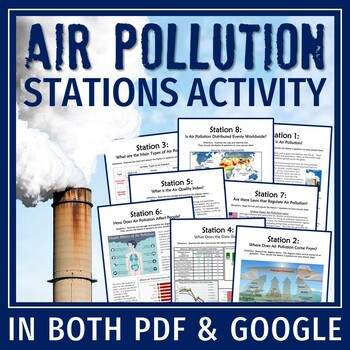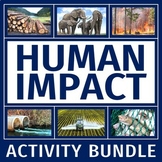Human Impact on Environment Air Pollution Activity Stations Print and Digital
- PDF
What educators are saying
Also included in
- Never search for "something to do tomorrow" ever again! This bundle contains PRINT AND GO lessons, NO PREP activities, LOW PREP labs, and ENGAGING articles to supplement and thoroughly enhance an Earth and space science course. Every included resource is easy to implement, standards-based, and high-Price $399.99Original Price $649.02Save $249.03
- SAVE 30% OFF LIST PRICES! Engage students with CRITICAL THINKING and DATA ANALYSIS as you cover many aspects of pollution:Air Pollution (Information Stations)Water Pollution (Practice Data Analysis)Land Pollution (Practice Graphing)Basics of Biomagnification (Engaging Text and Questions)IndividualPrice $14.99Original Price $21.96Save $6.97
- SAVE 35% off list prices! Engage students with CRITICAL THINKING as you teach them about how humans have impacted ecosystems around the world. The 12 included resources provide fun, NGSS-based activities for each of the following topics:Habitat Destruction Overharvested ResourcesInvasive SpeciesWatPrice $39.99Original Price $62.90Save $22.91
Description
Engage students with CRITICAL THINKING and DATA ANALYSIS as they learn about different aspects of air pollution!
⭐ Get this activity at a huge discount in our Pollution Activities Set! ⭐
Eight air pollution stations are included, each with a different focus question and short activity. Students practice different skills at each station all while learning about different aspects of air pollution. Station cards include text passages to read, diagrams to analyze, data and graphs to analyze, a map to interpret, and a timeline. Students answer questions on a corresponding worksheet as they move through each station.
Both PRINT AND DIGITAL versions are included!
Air Pollution Topics (1 Station Each):
- What is air pollution? (reading)
- Where does it come from? (diagram)
- What are the main types? (info-chart)
- How does it affect people? (text, infographic, and bar graph)
- Is it distributed evenly globally? (map analysis)
- What does the data show? (data table and graphs to analyze)
- What is the Air Quality Index? (text and chart)
- Are there air pollution laws? (text and timeline)
This Resource Includes:
- 8 Station/Activity Cards
- Student Answer Sheet (2 pages front/back)
- Digital Google Slides version of the activity
- Answer Key
This product has companion resources:
- Water Pollution Data Analysis
- Engaging "Flying Cats" Biomagnification Lesson (middle school level)
- Land Pollution: Graphing Garbage
Teacher Notes:
- No prior knowledge is required - all information in the questions comes directly from the information provided.
- Please note: this resource is not editable.
- Go paperless! This activity includes a version in Google Slides.
⭐⭐⭐Click here to get 5 FREE EARTH & SPACE SCIENCE lessons!⭐⭐⭐








